BUS707 Applied Research: Auditor Rotation and Performance Impact
VerifiedAdded on 2023/06/11
|8
|1089
|180
Report
AI Summary
This research report investigates the impact of auditor rotation on auditor performance, particularly within Australian listed companies. The study identifies the research problem as understanding the current state of auditor rotation in Australia and aims to analyze its effects on auditor independence and performance. A mixed-methods approach is employed, utilizing both primary and secondary data, with qualitative data analyzed through thematic analysis and quantitative data analyzed using statistical tools. The research design involves a descriptive study using simple random sampling of 50 public listed Australian companies. Ethical considerations are addressed to ensure compliance with research standards. The report references key literature on auditor rotation, audit quality, and corporate governance, providing a comprehensive overview of the topic and its implications for the Australian business environment. Desklib provides access to similar research papers and solved assignments for students.
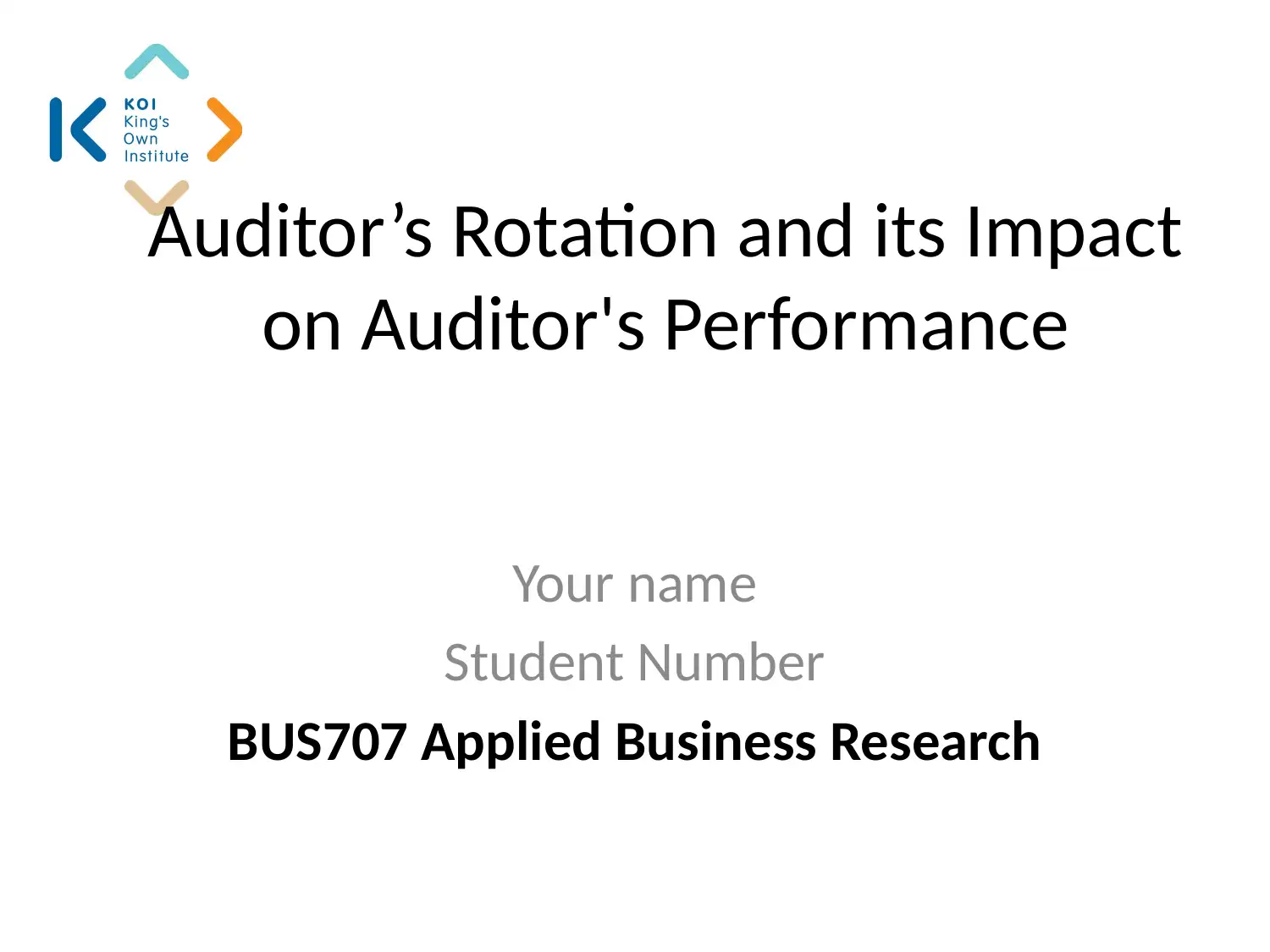
Auditor’s Rotation and its Impact
on Auditor's Performance
Your name
Student Number
BUS707 Applied Business Research
on Auditor's Performance
Your name
Student Number
BUS707 Applied Business Research
Paraphrase This Document
Need a fresh take? Get an instant paraphrase of this document with our AI Paraphraser
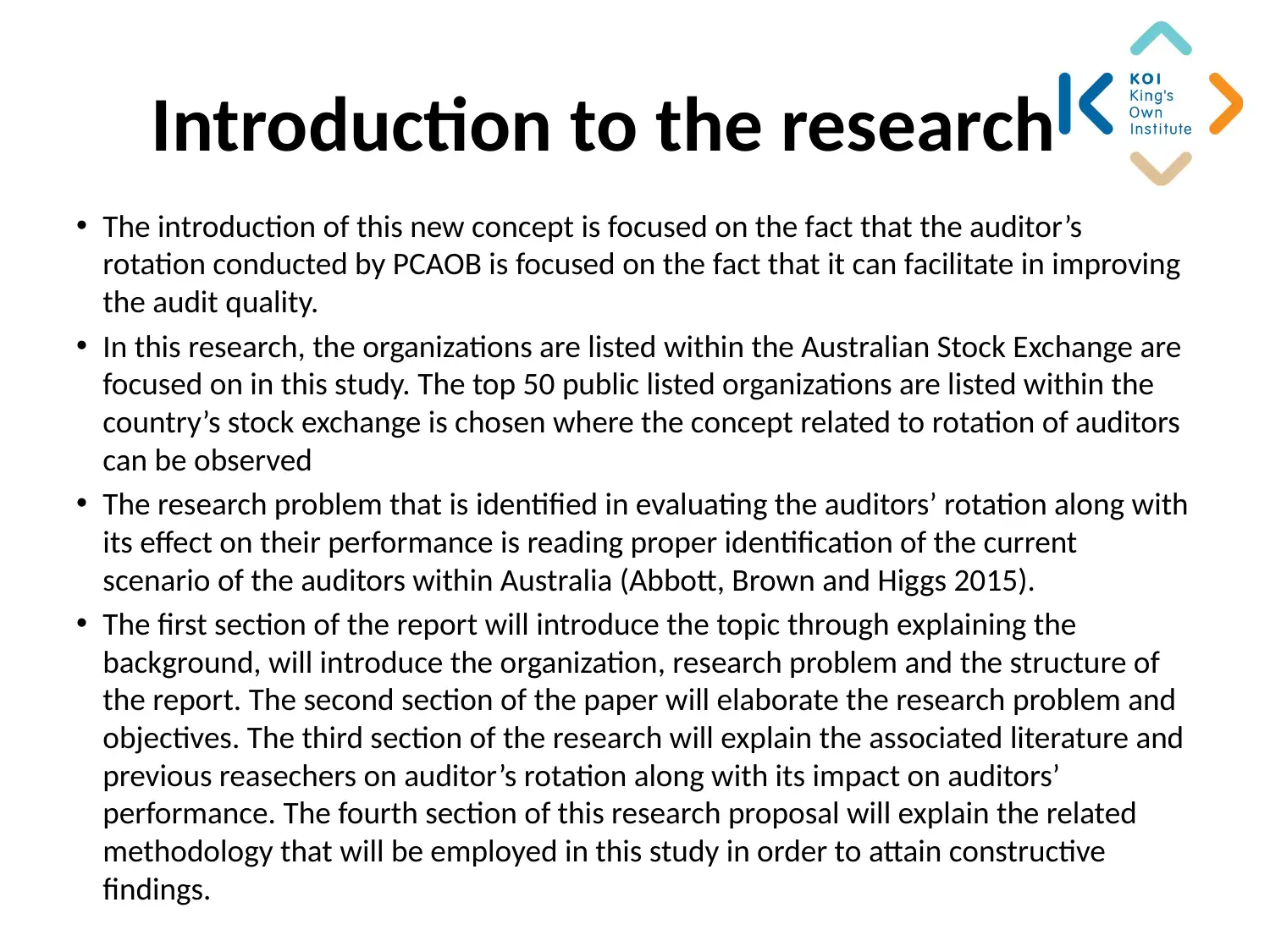
Introduction to the research
• The introduction of this new concept is focused on the fact that the auditor’s
rotation conducted by PCAOB is focused on the fact that it can facilitate in improving
the audit quality.
• In this research, the organizations are listed within the Australian Stock Exchange are
focused on in this study. The top 50 public listed organizations are listed within the
country’s stock exchange is chosen where the concept related to rotation of auditors
can be observed
• The research problem that is identified in evaluating the auditors’ rotation along with
its effect on their performance is reading proper identification of the current
scenario of the auditors within Australia (Abbott, Brown and Higgs 2015).
• The first section of the report will introduce the topic through explaining the
background, will introduce the organization, research problem and the structure of
the report. The second section of the paper will elaborate the research problem and
objectives. The third section of the research will explain the associated literature and
previous reasechers on auditor’s rotation along with its impact on auditors’
performance. The fourth section of this research proposal will explain the related
methodology that will be employed in this study in order to attain constructive
findings.
• The introduction of this new concept is focused on the fact that the auditor’s
rotation conducted by PCAOB is focused on the fact that it can facilitate in improving
the audit quality.
• In this research, the organizations are listed within the Australian Stock Exchange are
focused on in this study. The top 50 public listed organizations are listed within the
country’s stock exchange is chosen where the concept related to rotation of auditors
can be observed
• The research problem that is identified in evaluating the auditors’ rotation along with
its effect on their performance is reading proper identification of the current
scenario of the auditors within Australia (Abbott, Brown and Higgs 2015).
• The first section of the report will introduce the topic through explaining the
background, will introduce the organization, research problem and the structure of
the report. The second section of the paper will elaborate the research problem and
objectives. The third section of the research will explain the associated literature and
previous reasechers on auditor’s rotation along with its impact on auditors’
performance. The fourth section of this research proposal will explain the related
methodology that will be employed in this study in order to attain constructive
findings.
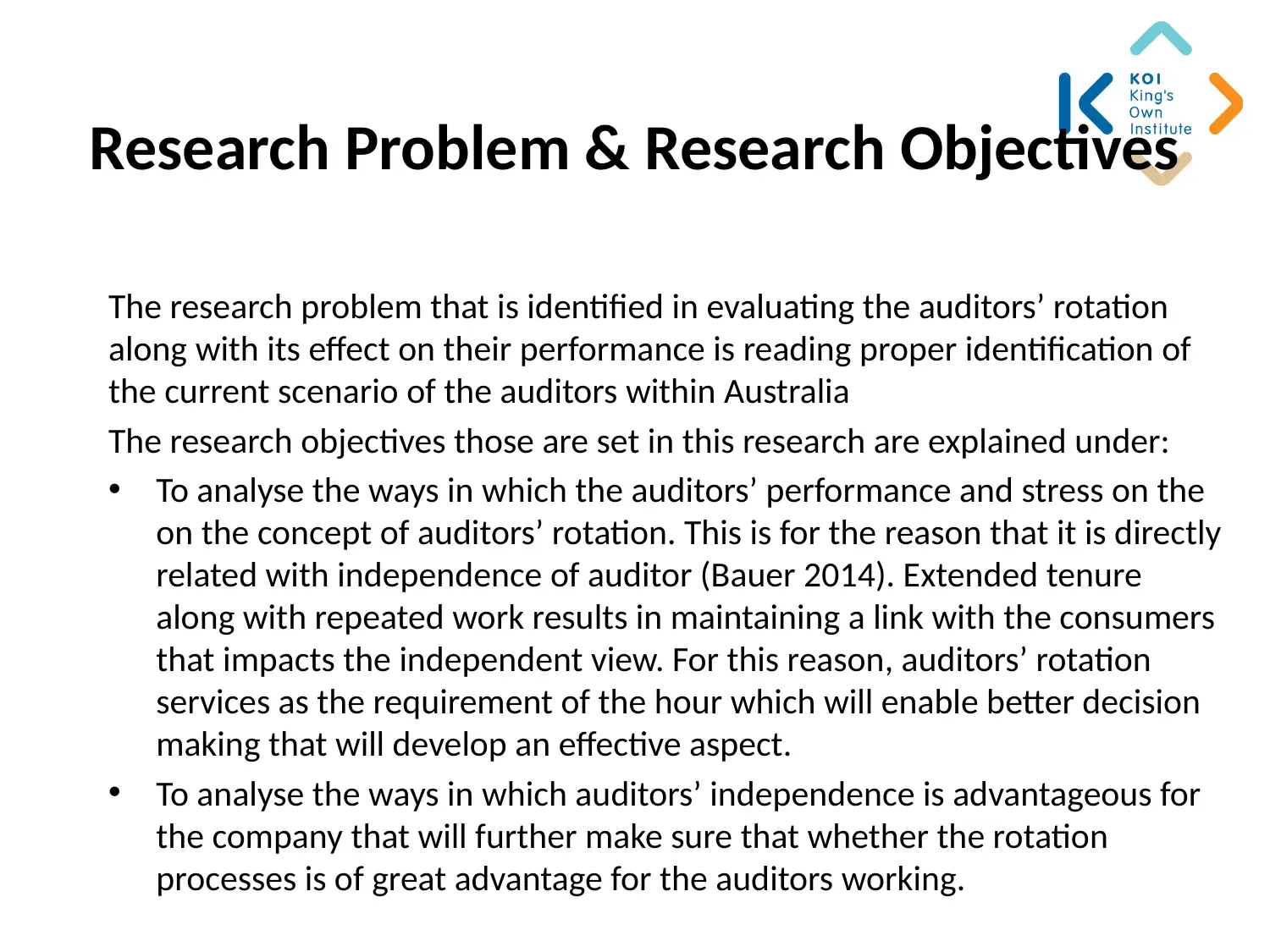
Research Problem & Research Objectives
The research problem that is identified in evaluating the auditors’ rotation
along with its effect on their performance is reading proper identification of
the current scenario of the auditors within Australia
The research objectives those are set in this research are explained under:
• To analyse the ways in which the auditors’ performance and stress on the
on the concept of auditors’ rotation. This is for the reason that it is directly
related with independence of auditor (Bauer 2014). Extended tenure
along with repeated work results in maintaining a link with the consumers
that impacts the independent view. For this reason, auditors’ rotation
services as the requirement of the hour which will enable better decision
making that will develop an effective aspect.
• To analyse the ways in which auditors’ independence is advantageous for
the company that will further make sure that whether the rotation
processes is of great advantage for the auditors working.
The research problem that is identified in evaluating the auditors’ rotation
along with its effect on their performance is reading proper identification of
the current scenario of the auditors within Australia
The research objectives those are set in this research are explained under:
• To analyse the ways in which the auditors’ performance and stress on the
on the concept of auditors’ rotation. This is for the reason that it is directly
related with independence of auditor (Bauer 2014). Extended tenure
along with repeated work results in maintaining a link with the consumers
that impacts the independent view. For this reason, auditors’ rotation
services as the requirement of the hour which will enable better decision
making that will develop an effective aspect.
• To analyse the ways in which auditors’ independence is advantageous for
the company that will further make sure that whether the rotation
processes is of great advantage for the auditors working.
⊘ This is a preview!⊘
Do you want full access?
Subscribe today to unlock all pages.

Trusted by 1+ million students worldwide
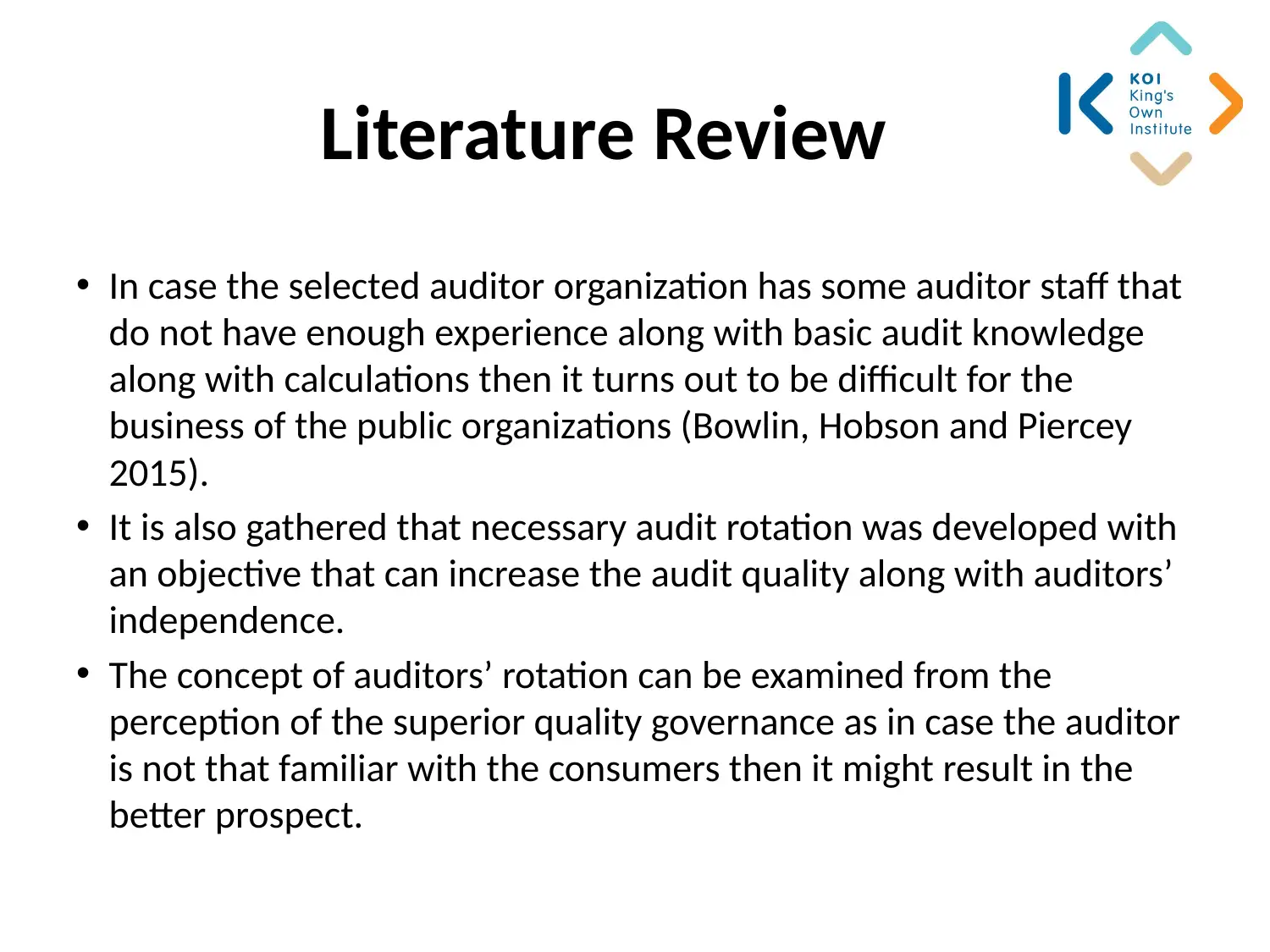
Literature Review
• In case the selected auditor organization has some auditor staff that
do not have enough experience along with basic audit knowledge
along with calculations then it turns out to be difficult for the
business of the public organizations (Bowlin, Hobson and Piercey
2015).
• It is also gathered that necessary audit rotation was developed with
an objective that can increase the audit quality along with auditors’
independence.
• The concept of auditors’ rotation can be examined from the
perception of the superior quality governance as in case the auditor
is not that familiar with the consumers then it might result in the
better prospect.
• In case the selected auditor organization has some auditor staff that
do not have enough experience along with basic audit knowledge
along with calculations then it turns out to be difficult for the
business of the public organizations (Bowlin, Hobson and Piercey
2015).
• It is also gathered that necessary audit rotation was developed with
an objective that can increase the audit quality along with auditors’
independence.
• The concept of auditors’ rotation can be examined from the
perception of the superior quality governance as in case the auditor
is not that familiar with the consumers then it might result in the
better prospect.
Paraphrase This Document
Need a fresh take? Get an instant paraphrase of this document with our AI Paraphraser
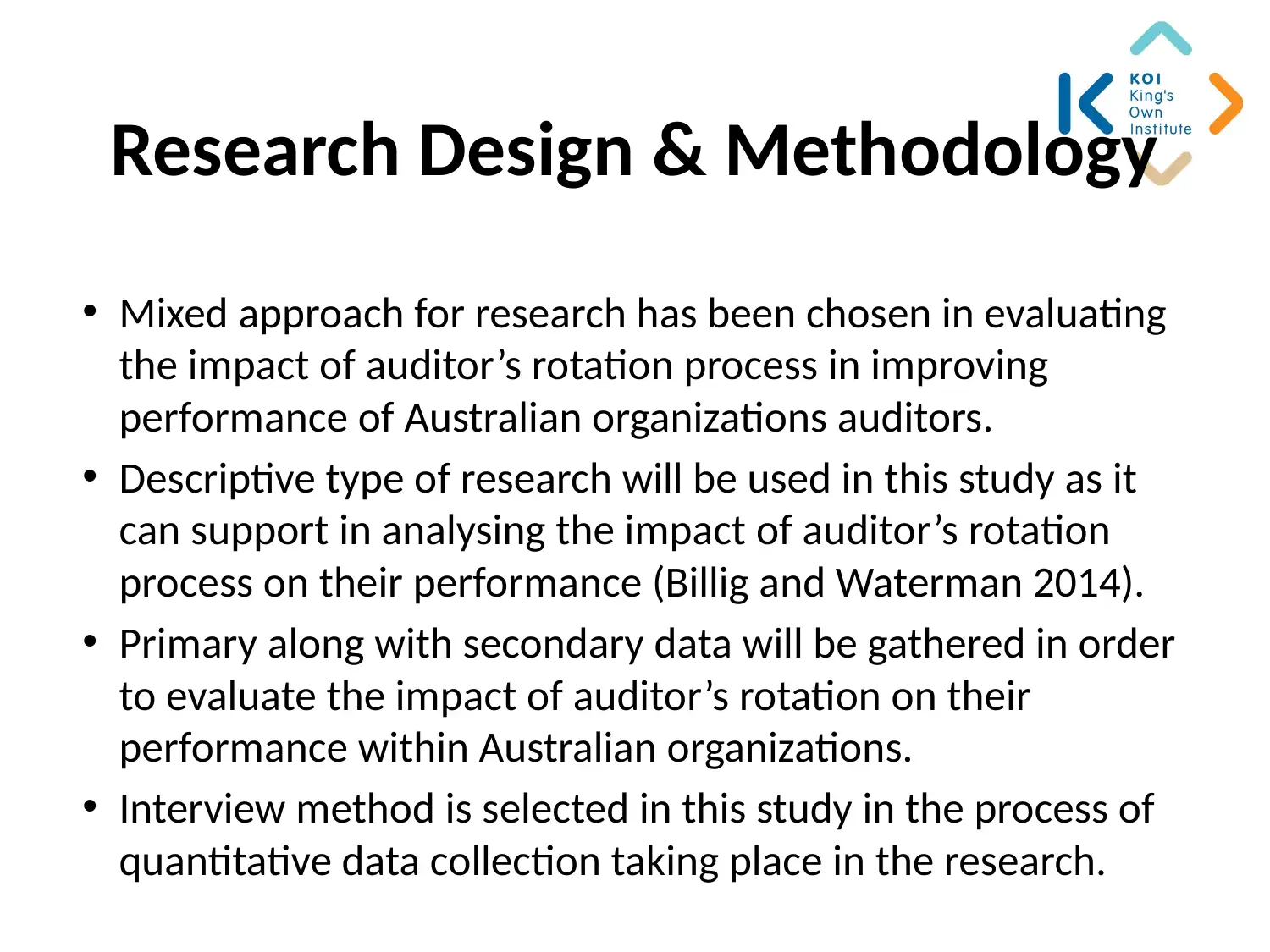
Research Design & Methodology
• Mixed approach for research has been chosen in evaluating
the impact of auditor’s rotation process in improving
performance of Australian organizations auditors.
• Descriptive type of research will be used in this study as it
can support in analysing the impact of auditor’s rotation
process on their performance (Billig and Waterman 2014).
• Primary along with secondary data will be gathered in order
to evaluate the impact of auditor’s rotation on their
performance within Australian organizations.
• Interview method is selected in this study in the process of
quantitative data collection taking place in the research.
• Mixed approach for research has been chosen in evaluating
the impact of auditor’s rotation process in improving
performance of Australian organizations auditors.
• Descriptive type of research will be used in this study as it
can support in analysing the impact of auditor’s rotation
process on their performance (Billig and Waterman 2014).
• Primary along with secondary data will be gathered in order
to evaluate the impact of auditor’s rotation on their
performance within Australian organizations.
• Interview method is selected in this study in the process of
quantitative data collection taking place in the research.
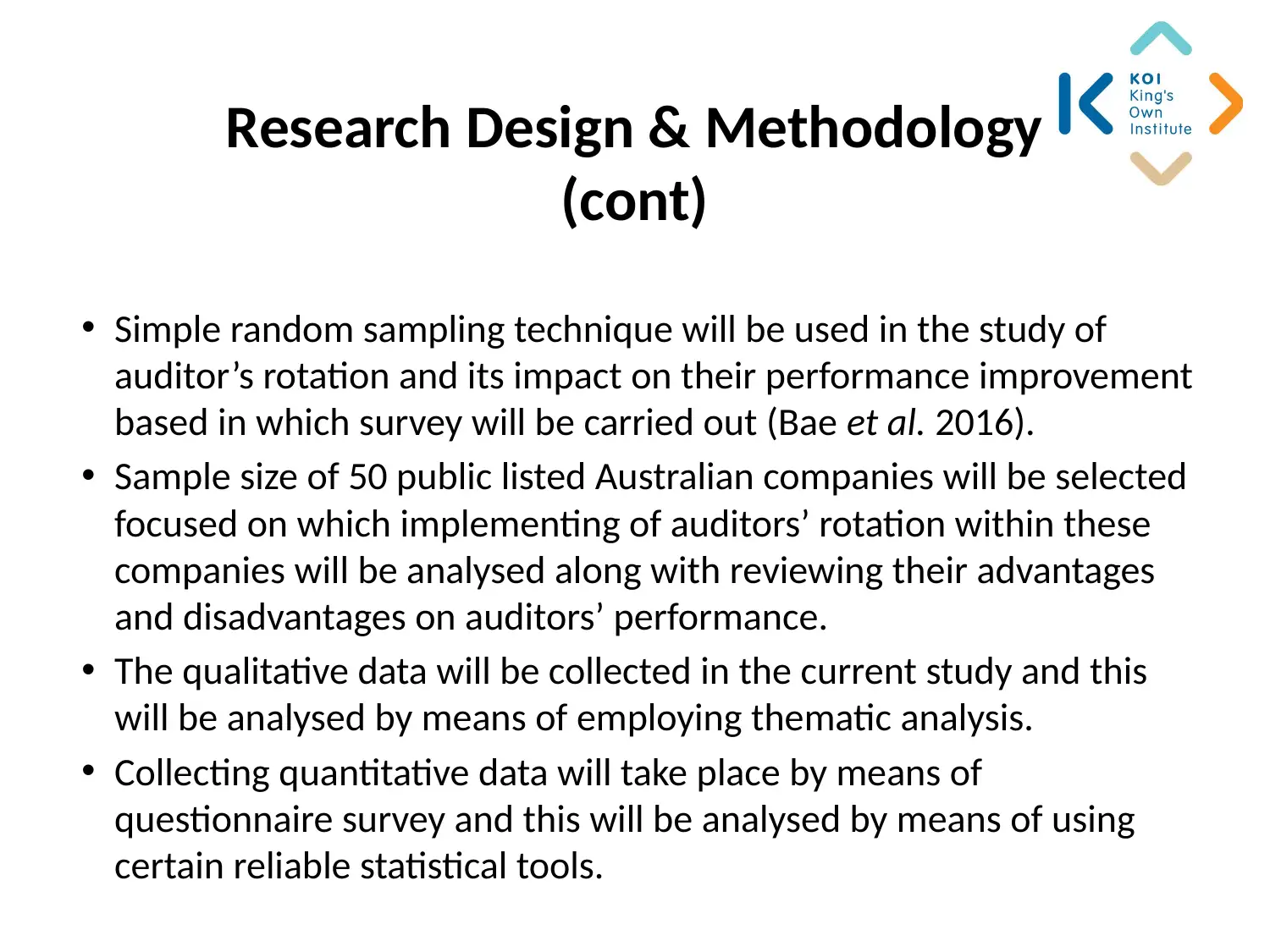
Research Design & Methodology
(cont)
• Simple random sampling technique will be used in the study of
auditor’s rotation and its impact on their performance improvement
based in which survey will be carried out (Bae et al. 2016).
• Sample size of 50 public listed Australian companies will be selected
focused on which implementing of auditors’ rotation within these
companies will be analysed along with reviewing their advantages
and disadvantages on auditors’ performance.
• The qualitative data will be collected in the current study and this
will be analysed by means of employing thematic analysis.
• Collecting quantitative data will take place by means of
questionnaire survey and this will be analysed by means of using
certain reliable statistical tools.
(cont)
• Simple random sampling technique will be used in the study of
auditor’s rotation and its impact on their performance improvement
based in which survey will be carried out (Bae et al. 2016).
• Sample size of 50 public listed Australian companies will be selected
focused on which implementing of auditors’ rotation within these
companies will be analysed along with reviewing their advantages
and disadvantages on auditors’ performance.
• The qualitative data will be collected in the current study and this
will be analysed by means of employing thematic analysis.
• Collecting quantitative data will take place by means of
questionnaire survey and this will be analysed by means of using
certain reliable statistical tools.
⊘ This is a preview!⊘
Do you want full access?
Subscribe today to unlock all pages.

Trusted by 1+ million students worldwide
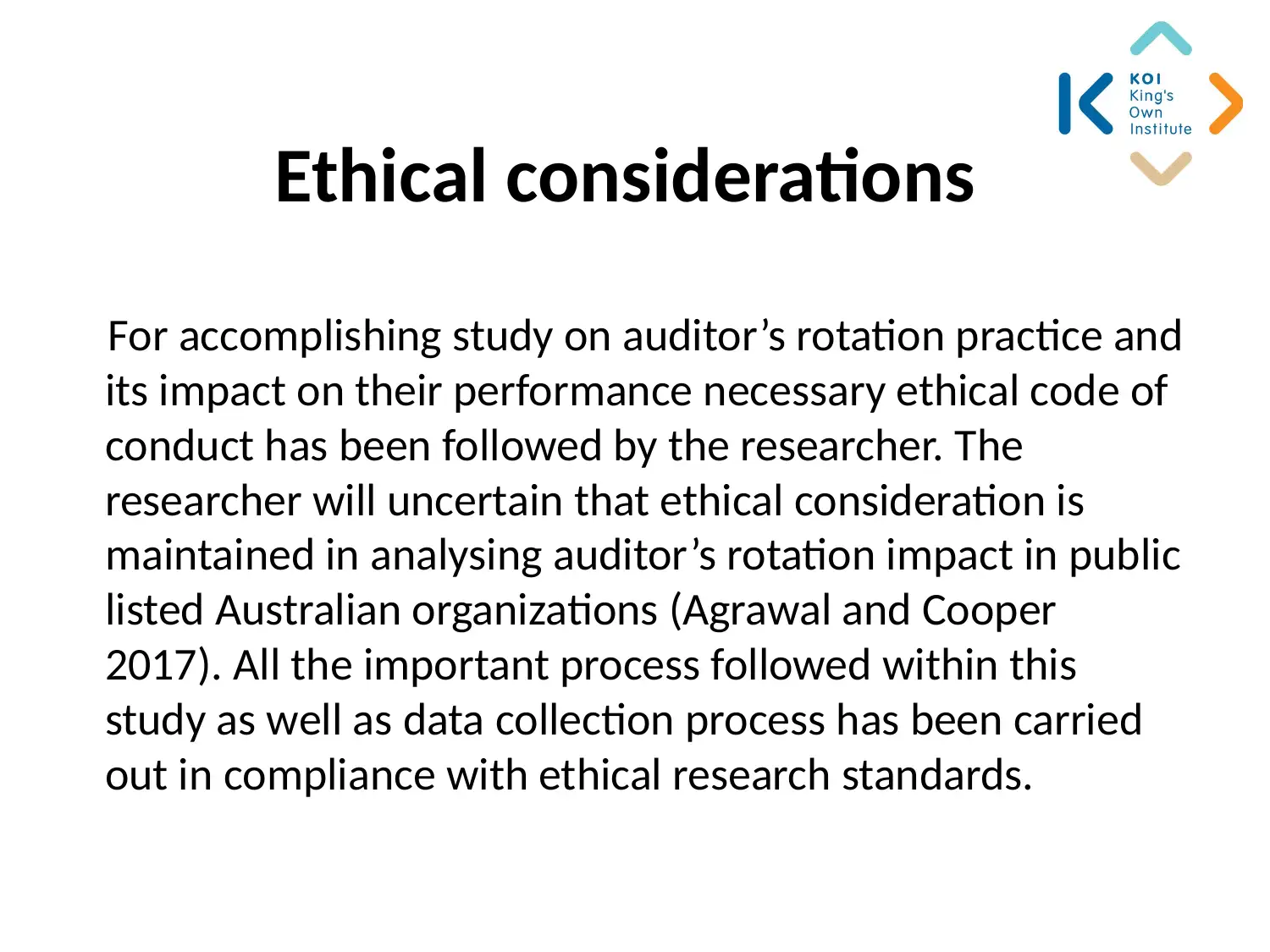
Ethical considerations
For accomplishing study on auditor’s rotation practice and
its impact on their performance necessary ethical code of
conduct has been followed by the researcher. The
researcher will uncertain that ethical consideration is
maintained in analysing auditor’s rotation impact in public
listed Australian organizations (Agrawal and Cooper
2017). All the important process followed within this
study as well as data collection process has been carried
out in compliance with ethical research standards.
For accomplishing study on auditor’s rotation practice and
its impact on their performance necessary ethical code of
conduct has been followed by the researcher. The
researcher will uncertain that ethical consideration is
maintained in analysing auditor’s rotation impact in public
listed Australian organizations (Agrawal and Cooper
2017). All the important process followed within this
study as well as data collection process has been carried
out in compliance with ethical research standards.
Paraphrase This Document
Need a fresh take? Get an instant paraphrase of this document with our AI Paraphraser
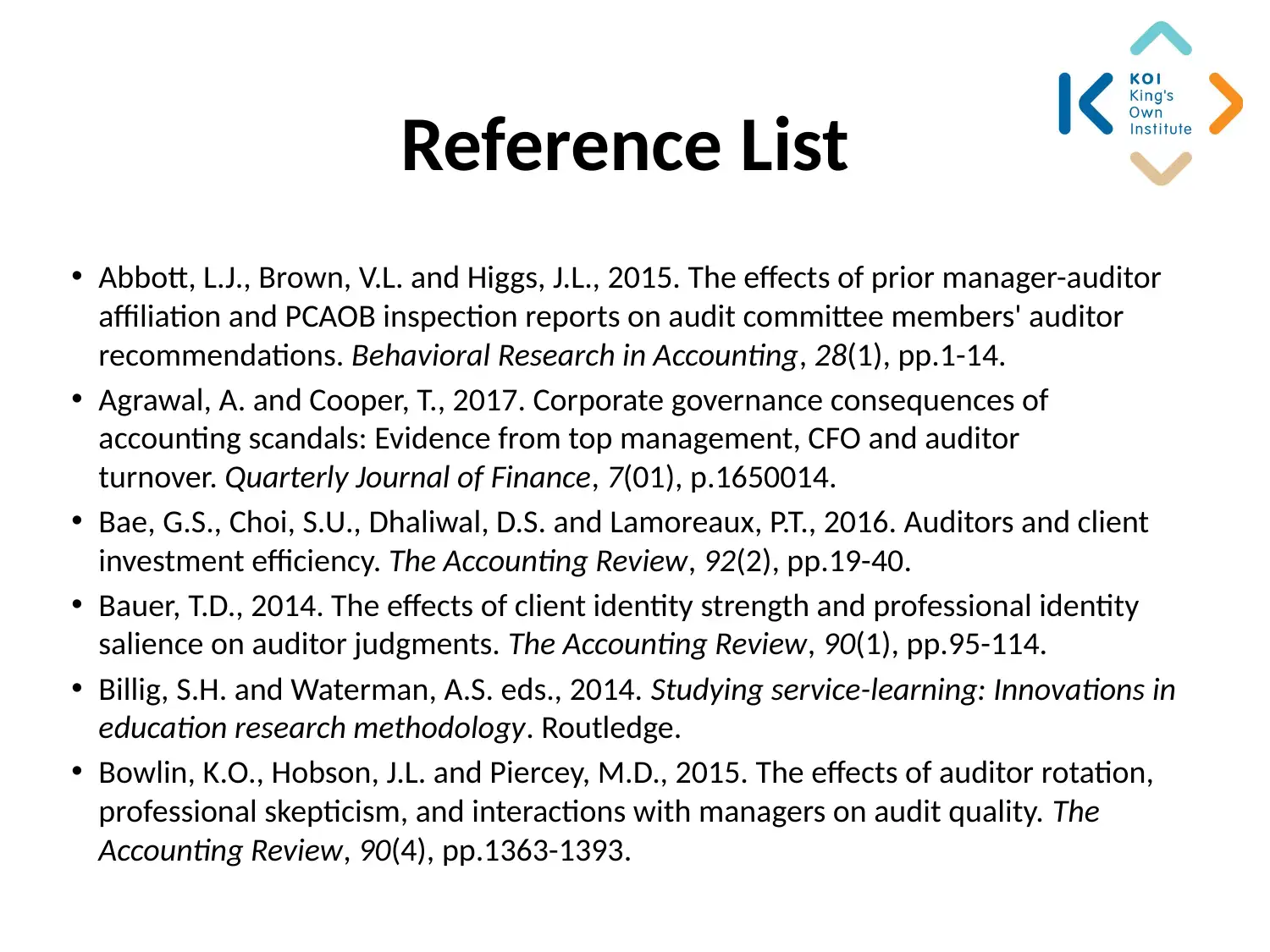
Reference List
• Abbott, L.J., Brown, V.L. and Higgs, J.L., 2015. The effects of prior manager-auditor
affiliation and PCAOB inspection reports on audit committee members' auditor
recommendations. Behavioral Research in Accounting, 28(1), pp.1-14.
• Agrawal, A. and Cooper, T., 2017. Corporate governance consequences of
accounting scandals: Evidence from top management, CFO and auditor
turnover. Quarterly Journal of Finance, 7(01), p.1650014.
• Bae, G.S., Choi, S.U., Dhaliwal, D.S. and Lamoreaux, P.T., 2016. Auditors and client
investment efficiency. The Accounting Review, 92(2), pp.19-40.
• Bauer, T.D., 2014. The effects of client identity strength and professional identity
salience on auditor judgments. The Accounting Review, 90(1), pp.95-114.
• Billig, S.H. and Waterman, A.S. eds., 2014. Studying service-learning: Innovations in
education research methodology. Routledge.
• Bowlin, K.O., Hobson, J.L. and Piercey, M.D., 2015. The effects of auditor rotation,
professional skepticism, and interactions with managers on audit quality. The
Accounting Review, 90(4), pp.1363-1393.
• Abbott, L.J., Brown, V.L. and Higgs, J.L., 2015. The effects of prior manager-auditor
affiliation and PCAOB inspection reports on audit committee members' auditor
recommendations. Behavioral Research in Accounting, 28(1), pp.1-14.
• Agrawal, A. and Cooper, T., 2017. Corporate governance consequences of
accounting scandals: Evidence from top management, CFO and auditor
turnover. Quarterly Journal of Finance, 7(01), p.1650014.
• Bae, G.S., Choi, S.U., Dhaliwal, D.S. and Lamoreaux, P.T., 2016. Auditors and client
investment efficiency. The Accounting Review, 92(2), pp.19-40.
• Bauer, T.D., 2014. The effects of client identity strength and professional identity
salience on auditor judgments. The Accounting Review, 90(1), pp.95-114.
• Billig, S.H. and Waterman, A.S. eds., 2014. Studying service-learning: Innovations in
education research methodology. Routledge.
• Bowlin, K.O., Hobson, J.L. and Piercey, M.D., 2015. The effects of auditor rotation,
professional skepticism, and interactions with managers on audit quality. The
Accounting Review, 90(4), pp.1363-1393.
1 out of 8
Related Documents
Your All-in-One AI-Powered Toolkit for Academic Success.
+13062052269
info@desklib.com
Available 24*7 on WhatsApp / Email
![[object Object]](/_next/static/media/star-bottom.7253800d.svg)
Unlock your academic potential
Copyright © 2020–2025 A2Z Services. All Rights Reserved. Developed and managed by ZUCOL.




